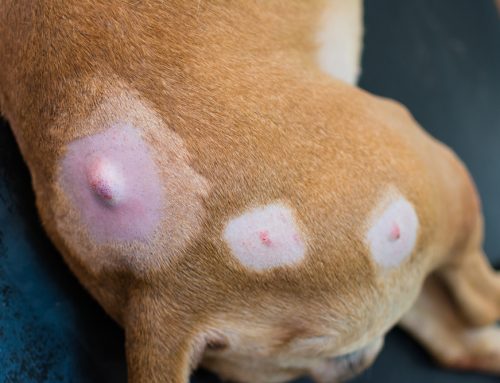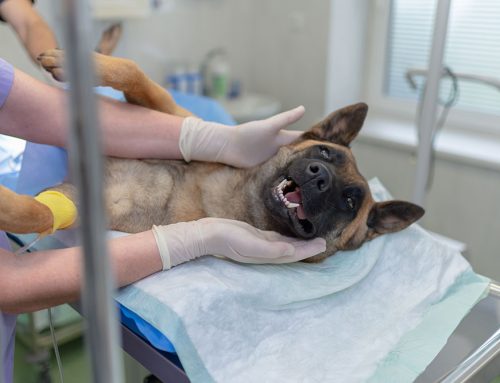If rising temperatures have you wiping sweat from your brow, your pet is feeling the heat, too. During the hot summer months, your pet is susceptible to heatstroke, a potentially life-threatening condition. Our team at Burlington Veterinary Center wants to educate you on this dangerous issue to help keep your pet cool and carefree.
#1: Your pet does not sweat like you do
When you sweat, the moisture on your skin evaporates, cooling your body. Pets do not have sweat glands over their entire body, but only a few around their nose and mouth, and some in their feet. Your pet mainly cools by panting and breathing. The air passing over the saliva in their mouth helps with cooling. Blood vessels in their face, ears, and feet also expand in response to heat, helping to further cool their body. These methods are not as efficient as sweating, however, so pets usually need to resort to external means to cool themselves. This is why pets lie directly over air conditioner vents and plop themselves in puddles when temperatures start to rise.
#2: Certain pets are more prone to heatstroke
Pets who have a flat, wide skull and a short nose (i.e., brachycephalic breeds) are predisposed to heatstroke. Boston terriers, bulldogs, boxers, and Persian cats are examples of brachycephalic pets. Their facial structure crowds their tongue and soft tissues in their mouth, restricting airflow, and making them ineffective panters. Older and overweight pets are also more heatstroke prone. Pets who are suffering from another medical issue, especially heart or respiratory problems, are also more sensitive to the heat.
#3: Your pet’s normal temperature is between 101 and 102.5 degrees
The best way to assess your pet’s temperature is to rectally take their temperature using a regular digital thermometer—ensure you know which thermometer is for human use and which is for pet use. Temperature readings higher than 103 degrees are concerning, but temperatures 105 and higher indicate heatstroke.
#4: Heatstroke is a medical emergency for your pet
As your pet’s temperature rises, an inflammatory process is triggered throughout their body that can damage multiple organs and body systems.
- The inflammation can cause swelling, hemorrhage, and necrosis in their brain.
- Heart damage can reduce the organ’s ability to pump blood effectively, leading to arrhythmias and shock.
- Lung tissue damage can cause respiratory distress.
- Inflammation in their kidneys can result in acute kidney failure.
- Gastrointestinal tract damage can cause release of bacteria into the bloodstream, which can then settle in organs, such as the heart and kidneys.
- Inflammation can cause a condition called disseminated intravascular coagulation (DIC) that results in severe bleeding from multiple body locations.
#5: If your pet is affected by heatstroke, initial signs may be subtle
Initially, your pet may only be lethargic and pant excessively, but as their temperature increases, other signs can include:
- Excessive drooling
- Vomiting
- Diarrhea
- Difficulty breathing
- Incoordination
- Seizures
- Collapse
#5: Your pet with heatstroke must be cooled down gradually
If you notice your pet exhibiting heatstroke signs, take them to a cool, well-ventilated area, and offer them cool drinking water. If their temperature is higher than 103, place them in a tepid water bath, ensuring their head always remains above the water level. Take their temperature every five minutes to monitor their progress. Once their temperature reaches 103, or if their temperature has not begun to fall after 10 minutes, take them to Burlington Veterinary Center immediately. If your pet appears to recover after they have cooled down, they still should be evaluated by a veterinary professional to ensure they have no internal damage.
#6: You can prevent your pet from being affected by heatstroke

If the temperature is above 80 degrees, or if humidity is high, you should be aware that your pet could fall victim to heatstroke unless you take certain precautions.
- Never leave your pet in a parked car. Temperatures inside vehicles quickly become dangerously high, and cracking a window does not prevent the temperature from becoming deadly for your pet.
- Provide fresh water for your pet, preferably from more than one source. When walking your pet, bring water bottles and a water bowl, and offer them frequent drinks.
- Avoid strenuous exercise on hot days, and walk in the early morning or late evening to avoid peak temperatures.
- Pets at high heatstroke risk should be kept inside an air-conditioned home, except for brief outdoor bathroom breaks.
Clipping your pet’s coat during the summer is a much debated topic The American Society for the Prevention of Cruelty to Animals (ASPCA) recommends trimming pets who are double-coated, such as the chow chow, but never shaving your pet. They need at least one inch of hair coat to protect them from the sun and provide insulation. Long-haired pets who have a single coat, such as border collies, should not be clipped, because their coat is not dense enough to offer protection from the sun when cut short.
You and your pet can enjoy this summer by taking steps to ensure your pet does not overheat. However, if you are concerned that your pet may have heat exhaustion, do not hesitate to contact our Fear Free team at Burlington Veterinary Center.







Leave A Comment